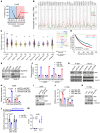A protumorigenic secretory pathway activated by p53 deficiency in lung adenocarcinoma
- PMID: 32931483
- PMCID: PMC7773359
- DOI: 10.1172/JCI137186
A protumorigenic secretory pathway activated by p53 deficiency in lung adenocarcinoma
Abstract
Therapeutic strategies designed to target TP53-deficient cancer cells remain elusive. Here, we showed that TP53 loss initiated a pharmacologically actionable secretory process that drove lung adenocarcinoma (LUAD) progression. Molecular, biochemical, and cell biological studies showed that TP53 loss increased the expression of Golgi reassembly and stacking protein 55 kDa (G55), a Golgi stacking protein that maintains Golgi organelle integrity and is part of a GOLGIN45 (G45)-myosin IIA-containing protein complex that activates secretory vesicle biogenesis in the Golgi. TP53 loss activated G55-dependent secretion by relieving G55 and myosin IIA from miR-34a-dependent silencing. G55-dependent secreted proteins enhanced the proliferative and invasive activities of TP53-deficient LUAD cells and promoted angiogenesis and CD8+ T cell exhaustion in the tumor microenvironment. A small molecule that blocks G55-G45 interactions impaired secretion and reduced TP53-deficient LUAD growth and metastasis. These results identified a targetable secretory vulnerability in TP53-deficient LUAD cells.
Keywords: Cell Biology; Lung cancer; Oncology; P53; Protein traffic.
Conflict of interest statement
Figures








Comment in
-
Targeting the mutant p53 secretome.J Clin Invest. 2021 Jan 4;131(1):e143945. doi: 10.1172/JCI143945. J Clin Invest. 2021. PMID: 33393496 Free PMC article.
References
-
- Li J, Stanger BZ. The tumor as organizer model. Science. 2019;363(6431):1038–1039. - PubMed
-
- Paltridge JL, Belle L, Khew-Goodall Y. The secretome in cancer progression. Biochim Biophys Acta. 2013;1834(11):2233–2241. - PubMed
-
- Coussens LM, Fingleton B, Matrisian LM. Matrix metalloproteinase inhibitors and cancer: trials and tribulations. Science. 2002;295(5564):2387–2392. - PubMed
Publication types
MeSH terms
Substances
Grants and funding
LinkOut - more resources
Full Text Sources
Other Literature Sources
Medical
Research Materials
Miscellaneous

